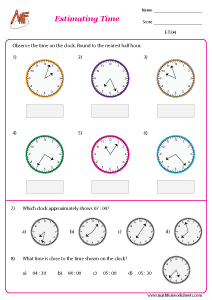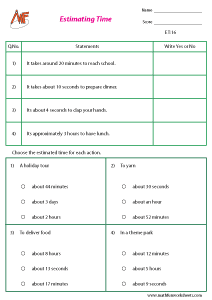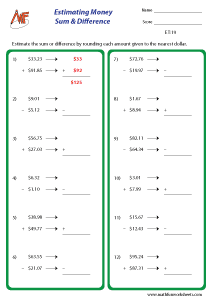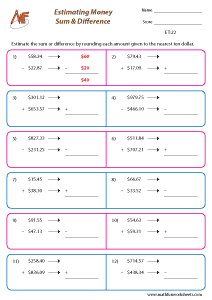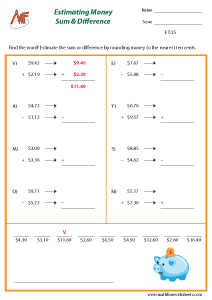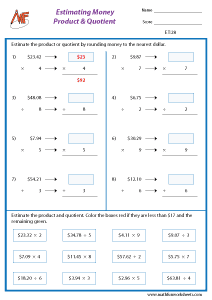- Home
- Numbers & Operations
- Estimation of Time and Money
Browse by Topics
- English Worksheets
- Science Worksheets
- Kid's Corner
- Numbers & Operations
- Addition
- Subtraction
- Multiplication
- Division
- Decimals
- Place Value
- Roman Numerals
- Skip Counting
- Odd & Even Numbers
- Patterns
- Cardinal & Ordinal Numbers
- Rounding Numbers
- Estimation of Numbers
- Estimation of Time & Money
- Counting & Cardinality
- Comparing Numbers
- Ordering Numbers
- Fractions
- Prime & Composite Numbers
- Squares & Cubes
- Square & Cube Root
- Divisibility Rules
- Factors & Multiples
- Data Handling
- Algebra
- Ratio
- Least Common Factor
- Greatest Common Factor
- Percent Worksheets
- Proportion
- Order of Operations
- Scientific Notation
- Exponents
- Algebraic Expressions
- Evaluating Algebraic Expressions
- Simplifying Algebraic Expressions
- Graphing Lines
- Point Slope Form
- Two Point Form
- Two Intercept Form
- Equations
- Identifying Functions
- Evaluating Functions
- Function Table
- Domain and Range
- Trigonometric Charts
- Quadrants
- Polynomials
- Measurement
- Geometry
- Word Problems
Estimation of Time and Money Worksheets
Estimation of Time and Money Worksheets are excellent tools for helping students develop practical life skills through math. These worksheets teach learners how to make quick, reasonable guesses about time and money in everyday situations. They are especially useful for students in grade 3 to grade 5, where estimating becomes a key part of problem-solving and critical thinking.
These worksheets focus on two important areas: estimating how long an activity might take and approximating the cost of goods or services. For example, students may estimate how much time they need to complete a task or how much change they should receive after a purchase. These real-world examples help learners connect math with daily life.

Each worksheet provides structured problems that require students to round numbers and apply logical reasoning. This helps them think faster and make smarter decisions. Teachers use these worksheets in the classroom to strengthen mental math and financial literacy. Parents can also use them at home for extra practice.
As students move up in grade, the complexity of the worksheets increases. Grade 3 students may begin with simple rounding and basic time-telling tasks. By grade 5, they estimate total expenses, compare time durations, and solve multi-step word problems. This steady progression builds both confidence and skill.
Related Worksheets: Estimation of Numbers, Rounding Numbers
Estimation of Time and Money Worksheets
Estimating Time (Nearest Hour)

Estimating Time (Nearest Hour)
Estimating Time (Nearest Half Hour)

Estimating Time (Nearest Half Hour)
Estimating Time (Nearest Quarter)

Estimating Time (Nearest Quarter)
Estimating Time (Seconds, Minutes, Hour)

Estimating Time (Seconds, Minutes, Hour)
Estimating Time - Say yes or no

Estimating Time - Say yes or no
Estimating Money - Sum / Difference (nearest dollar)

Estimating Money - Sum / Difference (nearest dollar)
Estimating Money - Sum / Difference (nearest ten dollar)

Estimating Money - Sum / Difference (nearest ten dollar)
Estimating Money - Sum / Difference (nearest ten cents)

Estimating Money - Sum / Difference (nearest ten cents)
Estimating Money - Product / Quotient (nearest dollar)

Estimating Money - Product / Quotient (nearest dollar)
Estimating Money - Product / Quotient (nearest ten cents)

Estimating Money - Product / Quotient (nearest ten cents)
Moreover, these worksheets support different learning styles. Visual learners benefit from clock diagrams and money charts. Word problems challenge students to apply their knowledge in new ways. These varied formats keep learners engaged and motivated.
In conclusion, these worksheets are valuable for teaching students practical and essential math skills. They promote logical thinking, accuracy, and real-world understanding. Use them consistently to support growth in math for every grade, and prepare students for smart, everyday decision-making.


